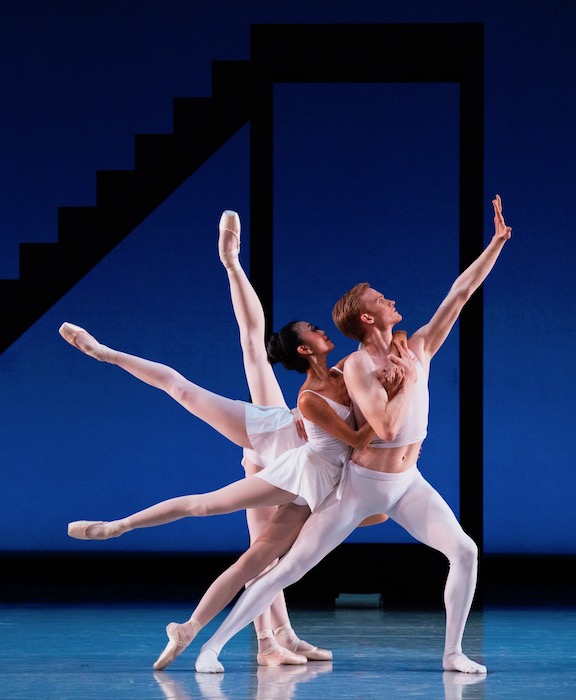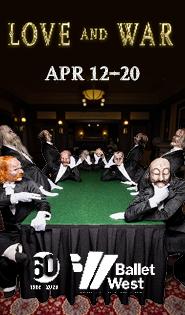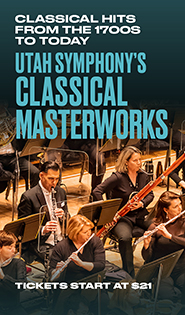Ballet West provides context and spectacle with “Balanchine’s Ballets Russes”

Typically a program note from an artistic director consists of a page or two of information about the performance and its significance.
For “Balanchine’s Ballets Russes,” the opening show of Ballet West’s 2019-2020 season, the program note by Adam Sklute sprawls to five well-filled and informative pages providing a thoughtful and thought-provoking essay covering the importance of the Ballets Russes, Ballet West’s investment in its productions, and historical connections between George Balanchine and Lew Christensen, the brother of Willam Christensen, founder of Ballet West.
This context and framing for the performance enriches its reception. We are seeing a choreographer’s early works, side by side in chronological order, years before Balanchine became the director of New York City Ballet. Performances feature Le Chant du Rossignol (1925), Apollo (1928) and Prodigal Son (1929), all performed by vibrant and stellar dancers. This Ballet West opener is like watching pages of history come alive.
Le Chant, with set and costumes by Henri Matisse and music by Igor Stravinsky, is a colorful spectacle that depicts a Hans Christian Andersen fairy tale about an ancient Chinese emperor enticed by a beautiful nightingale. When a mechanical nightingale, played superbly by Tyler Gum, is presented to The Emperor, he is seduced by the robotic creature in a classic tale of machine versus nature. Ultimately, the real nightingale, danced beautifully on Thursday night by Jenna Rae Herrera, battles Death to save The Emperor’s life. In the role of Death, Allison DeBona, dressed all in red and slicing through the choreography with dagger-like legs, was stunning.
But it’s the entire cast of 16 Court Ladies, six Warriors, four Chamberlains, and six Mandarins who transform the stage into a moving painting. Their formations juxtapose their costumes’ sumptuous designs, with one section by the Court Ladies suggesting the zig-zagging pattern of dancers in La Bayadere’s “Kingdom of the Shades.”
In the role of the Emperor’s Assistants, David Huffmire and Joshua Whitehead were fantastic: walking on their hands, catapulting through the legs of another dancer, and framing The Emperor like rays emanating from the sun.
In contrast to Le Chant, the Neoclassical Apollo, was stark and spare. Ballet West chose to perform the ballet’s initial birth-scene, something that other companies often exclude: Leto, seated on top of a tall platform, spreads her legs, and then Apollo jumps out from below. He is swaddled in fabric, which Hand Maidens unravel, and he dances his first solo as if a newborn, wobbly and unsure. By the end of the ballet he has gained his confidence and stability, and Adrian Fry, in the role of Apollo Thursday night, presents this evolution exquisitely.
The excellent cast also featured Katie Critchlow as Calliope, Chelsea Keefer as Polyhymnia, and Sayaka Ohtaki as Terpsichore. Staged by Colleen Neary, Apollo revealed the unique capacities of Ballet West’s dancers. They are refined technicians who bring artistry and exuberance to every role. Especially appreciated was the precise unison of their dancing as they step into fouettés that mark the corners of a square, showcasing right angles in their legs, wrists, arms, and spacing. In contrast to the opulence of Le Chant, this ballet is decidedly Apollonian.
The program closed with Prodigal Son, with Hadriel Diniz in the title role and Katlyn Addison as The Siren. Both dancers were exceptional: Diniz presents a youthful vigor that matches his character perfectly. He is strong and impetuous as he pounds his fists on his thigh, then soars through the air. Addison is statuesque and sultry, dominating Diniz as she seduces him. There are similarities between this Siren and the role of Death in Le Chant, both use their legs like weapons to ensnare a victim. Both ballets also feature a group of men creating a star formation that spins like a pinwheel. Thursday’s cast of these “Drinking Companions” was especially lively and compelling as they mimic and taunt the Son and his Friends.
In Adam Sklute’s program notes he describes how Balanchine and the composer of Prodigal Son, Sergei Prokofiev, did not get along: “At the time it was customary for the composer and scenic artist to receive royalties, but not the choreographer; the choreographer could receive a percentage of a composer’s royalty as a courtesy, almost like a tip. However, Prokofiev refused to share his royalties with the young, nearly impoverished Balanchine, and from that day on, Balanchine refused to choreograph to Prokofiev’s music.”
Along with Sklute’s essay in the booklet, there is an article by Phil Chan, co-founder of Final Bow for Yellowface, which examines the company’s careful approach to Le Chant, examining “how to revive the work with historical integrity without perpetuating offensive stereotypes for Chinese people.” This concern is complemented by panels of information in the lobby of the Capitol Theatre that describe how Ballet West met with members of Utah’s Asian-American community to view the choreography of Le Chant and identify aspects that may reinforce hurtful stereotypes. Another informational panel titled “Chinese History in Utah” explains the immigration of Chinese men to the United States and current demographics.
While one appreciates the cultural sensitivity displayed by the company, one wonders why Ballet West’s dancers in Le Chant needed to wear make-up suggesting white masks, as an alternative to make-up suggesting ethnic stereotypes. Were these masks even necessary at all?
In its totality “Balanchine’s Ballets Russes” is a testament to the power of collaboration, something that distinguished the Ballets Russes company itself. The dialogue generated by Sklute with Chan and others, and then shared through these performances, essays, and panels, shows that ballet history can be illuminating and instructive. The season opener is a glimpse into the past that teaches us about the power of the arts to communicate and uplift.
“Balanchine’s Ballets Russes” final performances are 2 p.m. and 7: 30 p.m. Saturday. balletwest.org

